How To Best Prepare A Restaurant Budget To Control Costs
Discover the best way to prepare a restaurant budget and learn what software too...

Creating a good retail schedule is one of the most important jobs you will face as a manager. Your schedule sets the tone for your business and is instrumental in establishing a strong and effective team.
A lot is riding on the names, dates, and times you put to paper, so it’s essential to do your best to create the best schedule possible.
To help you in that regard, the management experts at Sling have compiled tips for setting up an effective retail schedule in the shortest amount of time possible.

Take the time to analyze the sales periods of your retail establishment. When you do, you’ll notice peaks and valleys of activity. Use this information to plan shifts that provide the right number of employees for the traffic in your store.
Don’t restrict yourself to analyzing daily data. Look at patterns of activity for weeks, months, and even years. Then plan your shifts accordingly.
Sometimes, creating the best retail schedule for your business means scheduling a mix of full-time and part-time employees.
Varying the types of employees that work helps keep your full-time employees from accumulating overtime hours that can drive labor costs up. And allowing part-time employees to work alongside experienced full-timers provides valuable on-the-job training that you can’t get anywhere else.

An effective retail schedule allows for more than just who works when. It also helps you control costs to keep your business in the black.
Set up a budget before you start scheduling, and then arrange your shifts so that labor costs stay under those pre-arranged numbers.
Useful budget structures include flat rate (e.g., X dollars each week) or percentage of sales (e.g., X percent of payroll per day, week, or month). Use the method that works best for your business.
You can drastically reduce the time it takes to schedule your employees by first creating a custom template for the job.
When it’s time to arrange the schedule for the next week, month, or quarter, you can get right to assigning names to shifts rather than worrying about fonts and borders and how the schedule is going to look.
All businesses go through busy times and slow times. Analyzing your peak sales periods (tip #1 on this list) will show you when those busy and slow times occur.
Armed with that data, you can arrange shifts so that at least one of your best employees is available during the busiest hours.
Scheduling your employees this way — rather than going straight through Monday to Sunday — ensures that peak activity in your business is covered by an experienced employee or two who can handle the flow of customers.

Your employees will appreciate your retail schedule even more when you keep it simple and easy to read. You should be able to look at the schedule and figure out the day, the hours, and the job an employee will work in just a few seconds.
If you have to read really closely and think about the information in order to decipher the schedule, you may need to make some changes, reduce the amount of data the schedule contains, or simplify the appearance.
Publishing your retail schedule with plenty of lead time allows your employees to:
If you post the schedule the day before it goes into effect, your employees won’t have time to make accommodations for work and personal appointments. That will lead to no-call, no-show employees and put most of the responsibility for finding replacements on your shoulders.
When you post your schedule with plenty of lead time, consider allowing employees to make changes—within certain limits.
Encourage your employees to find their own substitutes well in advance if they can’t work a certain shift, but ensure they understand that you must approve all changes first.

Once the retail schedule goes into effect, keep employees on task with to-do lists sent right to their phones.
Harnessing the power of mobile devices to ensure that your employees are engaged and working efficiently means that there’s less information needed on your schedule. It also means that you can track the progress of the tasks you assign to make sure each job gets done on time.
Communication is important for any business. But, in the retail industry, it can mean the difference between having enough employees to cover a shift and being short-staffed.
With most people using smartphones these days, your best bet is to choose a method that makes use of this technology. For example, texting your employees or using instant messenger.
Another great option is the Sling app. Sling is a tool made specifically for retail so it takes all the guesswork out of staying in touch with your team.
Our software couples powerful retail scheduling tools with equally powerful communications tools and allows you to streamline intra-business interaction through push notifications, chatting, and media sharing (e.g., messages, photos, videos, and links).
In addition, you can communicate with a specific individual, a group, or all employees at the same time. These and other communication features make Sling your best bet for team-wide business communication.

Consistency is key when it comes to posting a new retail schedule. It should occur on the same day and at the same time every week (or every two, three, or four weeks, depending on your system).
For example, if you decide to post the new schedule on the last Tuesday of the month by 12 p.m., it should always be posted on the last Tuesday of the month at or before 12 p.m.
Once you’ve established the day and time you want to release the new schedule, you can work backward from there to set deadlines for yourself and your staff. With Tuesday at 12 p.m. as your deadline, give yourself most of Monday and all of the Friday before to create the schedule.
It may not take you that long, but you never know when an emergency might pop up. With Friday and Monday as your scheduling days, that means you can accept employee requests for vacations, preferred work days, and preferred shifts until as late as Monday night.
Setting up a consistent process for retail schedule creation — and sticking to it — can help you keep this complicated and daunting task simple.
Your consistency also helps your employees know what to expect. They know they have until a certain day to inform you of their schedule. And they can rely on the fact that the new schedule will always be released at the same time.
The thing about scheduling that most managers forget is that they don’t have to do all the heavy lifting on their own. Giving your employees permission to self-schedule is a great way to:
Consider scheduling one or two of your best employees for each shift as a way to start. Then, give everyone access to this incomplete schedule and allow them to fill in when they want to work.
If you want to try self-scheduling to see if it works, try this simple framework:
If you’re used to scheduling everything yourself, you might consider trying this new method for a few scheduling cycles to see if it’s an effective method for your business.
Our Sling software makes self-scheduling extremely easy. You create a common document online and then give everyone access to that document for a few days.
When it’s time to finalize the schedule, close the document, make your changes, and then reopen it for viewing. It’s just that easy.

Making your employees responsible for finding a substitute to cover a shift they can’t work is another way to reduce your own workload.
Instead of the employee calling you (or texting or emailing) to say they can’t come in, they can send out a notification informing everyone that their shift is up for grabs.
With the right communication process in place, employees who are willing to work can respond in a matter of moments. Now, something that might have taken you an hour or more and countless phone calls can be resolved in a matter of minutes.
That said, you should always have guidelines in place to make sure things don’t get out of hand and negatively affect your business.
For example:
Giving your employees the responsibility to find their own substitutes is a great way to instill a sense of maturity and thoughtfulness in your team.
In addition, it helps employees feel engaged in the business and to think about what all goes into creating a retail schedule. By showing them the other side of the process, you can create a sense that your staff rota isn’t something to be changed at the drop of a hat. If they’re scheduled, and they’re able, they need to work.
As beneficial as it is to give your employees the responsibility to find their own substitutes, sometimes no one will step up to cover the vacant shift.
When that happens, it’s up to you to find someone to fill in. Iit’s in these moments that you need an availability chart to make the whole thing go more smoothly.
Emergencies will come up. It’s inevitable. But rather than leaving it all to chance, an availability chart can act as your “plan B.”
The simplest chart can just be a list of each employee and what days and times they’re available to work. They may not be scheduled for all those days and times, so they may be willing to pick up an extra shift here or there.
A more complicated version of this chart is another full retail schedule listing available employees who can come in during every shift.
Think of your availability chart like the second string on a basketball team. If someone can’t “play,” you’ve got several choices who would be willing to come off the bench.
Ultimately, this simplifies the substitute process by taking the thought out of it. It can also reduce the stress involved when the need for a last-minute substitute arises.

If you’ve been a manager for any length of time, you know that no matter how carefully and how well you plan, something will go wrong (“The best-laid plans of mice and men…” and all that).
Even though you’ve got an availability chart that outlines employees who are available to work on short notice, you may need a backup to this backup — a plan C to your plan B, if you will.
That’s why we recommend setting up a list of trusted and reliable part-time workers you can contact when all your other options have failed. These workers may be former employees who left on good terms or prospective employees who interviewed but didn’t get hired.
You may think these people would never be willing to come in on such short notice, but you never know until you ask. Former employees may look forward to working with your team again, and prospective employees may jump at the chance to get a toe in the door.
No retail schedule or scheduling process should be set in stone. Every few months, reevaluate the finished product and the steps you took to get there and enact changes to make it even better.
Even relatively minor tweaks that may seem inconsequential at first can have a significant effect on how your team works. If a modification doesn’t work, you can always scrap it, go back to the way you did it before, and then try something new.
It’s also beneficial, at times, to get a different perspective on the process by asking your employees for suggestions on how they would improve the retail schedule or the process as a whole. Implement the best ideas and see if they improve the workflow.

If you still rely on programs like Microsoft Word, Excel, or their online counterparts for your scheduling needs, it’s time to upgrade.
Retail-specific apps like Sling offer a wide range of tools that simplify and streamline the scheduling process so you can create the best retail schedule possible and still have time to focus on tasks that drive your business forward.
And upgrading won’t cost an arm and a leg over the programs you’re used to. Sling gives you free access to everything you need to schedule employees and handle internal communication for teams of up to 50.

In addition to the powerful scheduling tools, Sling also offers:
These features give you unprecedented control over an inherently complicated and chaotic process and make it easier than ever to create the best retail schedule for your team and your business.
For more free resources to help you manage your business better, organize and schedule your team, and track and calculate labor costs, visit GetSling.com today.
See Here For Last Updated Dates: Link
This content is for informational purposes and is not intended as legal, tax, HR, or any other professional advice. Please contact an attorney or other professional for specific advice.
Schedule faster, communicate better, get things done.